
Abstract: In response to the challenges faced by existing aircraft platform cooperative networking, such as vulnerability to interception, susceptibility to interference, low data rates, and difficulty in adapting to complex battlefield environments, several solutions are analyzed. A Terahertz cooperative networking solution with characteristics such as anti-interception, anti-jamming, and high data rates is proposed. Research is conducted on the application of Terahertz technology in aircraft platform networking from aspects such as networking styles, usage patterns, ultra-wideband baseband processing, and compensation for non-ideal characteristics of RF/baseband hardware. Finally, the prospects of Terahertz technology in cooperative networking of aircraft platforms are discussed.
Keywords: Terahertz communication; aircraft cooperative networking; high transmission rate; anti-jamming; anti-interception

1 Introduction
Terahertz radiation refers to electromagnetic waves with frequencies ranging from 0.1 to 10 THz (1 THz = 1012 Hz), which is in the transition zone from macroscopic classical theory to microscopic quantum theory, and from electronics to photonics. Its frequency is higher than microwaves and lower than infrared, located at the intersection of infrared and microwave.
Terahertz technology has the following characteristics in high-speed flight platform applications.
(1) High data rates: The pulse width of Terahertz signals is on the order of picoseconds, providing high temporal resolution; the frequency of each Terahertz pulse can range from several GHz to dozens of THz, effectively suppressing background noise interference and enabling high-speed, wide-bandwidth wireless communication.
(2) Narrow beam: The beam width of Terahertz signals is narrow, around 0.5°, with strong directionality, anti-interference, and anti-interception capabilities.
Based on these characteristics, Terahertz technology has significant application value in high data rate communication, secure communication, radar detection, and more.
In 2017, Brown University achieved a Terahertz communication rate of 50 Gbps. In 2019, NYU Wireless Center developed wireless technology with a Terahertz channel transmission rate of 100 Gbps.
In 2010, NTT Corporation of Japan generated Terahertz signals through indium phosphide high electron mobility transistor integrated circuits, achieving a transmission rate of 10 Gbps; in 2012, they used ASK amplitude modulation to achieve a real-time transmission rate of 10 Gbps. In 2012, the National Institute of Information and Communications Technology in Japan achieved 24 Gbps wireless transmission in the 300 GHz band using single-carrier photodiodes and Schottky barrier diode detectors; in 2014, they achieved real-time transmission at 50 Gbps using orthogonal phase shift keying modulation format in the 300 GHz band. In 2017, NTT Corporation developed a communication transmission system with a data transmission rate of up to 105 Gbps in a single channel at 300 GHz.
Karlsruhe Institute of Technology in Germany achieved a 25 Gbps Terahertz transmission rate in 2012 using key control methods; in 2013, they achieved a transmission rate of 100 Gbps at a center frequency of 237.5 GHz using optoelectronic methods with 16QAM modulation. In 2017, Duisburg-Essen University in Germany achieved a transmission rate of 59 Gbps at a center frequency of 328 GHz using high spectral efficiency 64-QAM-OFDM modulation. In 2017, the Braunschweig Terahertz Communication Laboratory in Germany transmitted broadband composite modulated signals at a data transmission rate of up to 64 Gbps at a carrier frequency of 300 GHz, with a maximum transmitter symbol rate of 32 Gbps.
According to currently available information, DARPA’s “RF Backbone” project has achieved 10 Gbps millimeter-wave transmission over a distance of 30 km for air-to-ground links, with an onboard MIMO antenna aperture distance of 10 m and a total onboard device weight of approximately 180 kg, while the ground device MIMO antenna aperture distance is 40 m, with a total ground device weight of approximately 230 kg. There is still a significant gap between the transmission distance, speed, and device miniaturization compared to their target values.
At the same time, as the requirements for autonomy, intelligence, and multi-tasking of aircraft platform applications continue to rise, the operational efficiency and intelligence levels of single aircraft platforms can no longer meet the operational needs of aircraft combat tasks. The integrated strike chain of reconnaissance, control, attack, and assessment by weapon systems is gradually becoming mainstream. In the area of onboard cooperative networking applications, the U.S. military has developed and equipped several types of missiles, such as the Joint Standoff Weapon-Extended Range (JSOW-ER), which is equipped with Rockwell Collins’ TacNet 1.0 data link (i.e., a bidirectional strike universal weapon data link SCWDL), enabling missiles to update cooperative target data in real-time provided by the launch platform or missile platform, thereby allowing them to update their flight paths in real-time during flight.
In summary, the highly integrated application of aircraft platforms and cooperative networking data links has become a trend. However, there is currently limited literature reporting on the miniaturization development of aircraft platforms based on Terahertz technology, and the integration of Terahertz technology with aircraft platforms has not yet reached a mature application level.
2 Challenges Facing Aircraft Cooperative Networking
As aircraft swarm combat gradually replaces single platform combat, how to significantly enhance the application effectiveness of cooperative networking technology among aircraft platforms in swarm combat has become a current research hotspot. The main issues facing aircraft cooperative networking include the following:
(1) High transmission rate: To achieve efficient situational information sharing, signal-level cooperation is required, which necessitates the transmission of raw data from sensors. The data transmission rate of individual aircraft platform sensors exceeds 100 Mbps, and the throughput of the swarm network exceeds 1 Gbps. Traditional low-frequency communication cannot meet such high-speed transmission requirements.
(2) Anti-interception: Currently, cooperative networking for aircraft swarms mostly adopts low-frequency wide-beam cooperative networking transmission modes. During the cooperative flight of aircraft, the radiated wide-beam electromagnetic waves are easily detected by various electronic reconnaissance means and subjected to electromagnetic countermeasures, directly affecting the overall effectiveness of the aircraft swarm.
(3) Anti-jamming: During the process of striking targets, aircraft platforms must enter the target area and face complex electromagnetic countermeasures, with the network potentially being attacked at any time. When nodes suffer from network jamming, attacks, or failures, the throughput, end-to-end delay, network connectivity, and service carrying capacity of the network will all deteriorate significantly, directly impacting the cooperative communication support level of the aircraft platforms.
3 Comparative Analysis of Solutions
Existing aircraft cooperative networking primarily uses frequency bands below Ka. To enhance the adaptability of existing aircraft cooperative networking to complex battlefield environments, whether addressing the current high-speed transmission requirements of cooperative networking, improving anti-jamming capabilities, or significantly reducing the signal beam width to avoid interception by various electronic reconnaissance means, it is necessary to elevate the operating frequency of existing aircraft cooperative networking.

Figure 1: Position of Terahertz Waves in the Electromagnetic Spectrum
As shown in Figure 1, the Terahertz frequency band and infrared laser frequency band are both higher than the frequency bands currently used for aircraft cooperative networking. However, compared to Terahertz technology, infrared laser communication has the following shortcomings in current usage:
(1) Beam too narrow: Due to the ultra-narrow beam of infrared lasers, wireless communication must be point-to-point, and there is insufficient window to provide for the infrared laser head on aircraft platforms. The limited search window restricts the search range of infrared laser beams, making infrared laser communication unable to meet current cooperative networking demands, while Terahertz technology can address related issues with phased array antennas.
(2) Device size: Infrared laser communication devices are typically large, occupying valuable space on aircraft platforms.
(3) Power limitations: Current infrared laser communication devices are limited by component and other technical constraints, unable to achieve high power, resulting in transmission distances only in the tens of kilometers. In contrast, the communication distance for aircraft platform cooperative networking reaches hundreds of kilometers, making infrared laser unsuitable for cooperative networking.
(4) Atmospheric effects: When used in the atmosphere, the random fluctuations in atmospheric refractive index cause turbulence that leads to random fluctuations in the amplitude and phase of the optical signal. Additionally, frequency shifts and noise caused by non-ideal components such as lasers and detectors also affect the performance of optical communication.
4 Application of Terahertz Technology in Cooperative Networking
The application of Terahertz technology in aircraft cooperative networking can address the issues of low transmission rates, susceptibility to interference, and vulnerability to interception faced by low-frequency bands during cooperative networking. This analysis focuses on the overall design technology of multi-platform cooperative networking and the key technologies of Terahertz cooperative networking.
4.1 Overall Design Technology of Multi-Platform Cooperative Networking
4.1.1 Cooperative Networking Style Design Technology
The multi-aircraft platform cooperative networking technology based on Terahertz can integrate various aircraft platforms into an organic whole for coordinated search, detection, and penetration. Due to the high-speed transmission characteristics of Terahertz technology, the multi-platform cooperative networking technology can efficiently share information in heterogeneous swarms in typical application scenarios, enhancing the overall application performance of the platform swarm.

Figure 2: Terahertz Cooperative Networking Formation
4.1.2 Cooperative Networking Usage Mode Design Technology
Due to the strong directionality of Terahertz communication links, there is a significant difference from the wide-beam coverage commonly used in most low-frequency communication systems. This characteristic makes the “broadcast” method commonly used in low-frequency cooperative networking no longer applicable, greatly impacting the establishment and maintenance of the network; in addition, this characteristic makes spatial division multiple access technology a reality, allowing multiple transmission links to be concurrently transmitted, thereby improving transmission efficiency.
Given the limited communication range covered by the narrow beam of Terahertz, nodes need to perform multiple neighbor scanning detections in multiple or even all directions to be aware of all adjacent nodes.
For communication between a pair of neighboring nodes, it is necessary to know the relative direction of the neighbors. The process by which neighboring nodes discover each other and obtain their relative directions is known as the neighbor discovery process. During the neighbor discovery process, a pair of neighboring nodes must meet the node convergence conditions to discover each other.
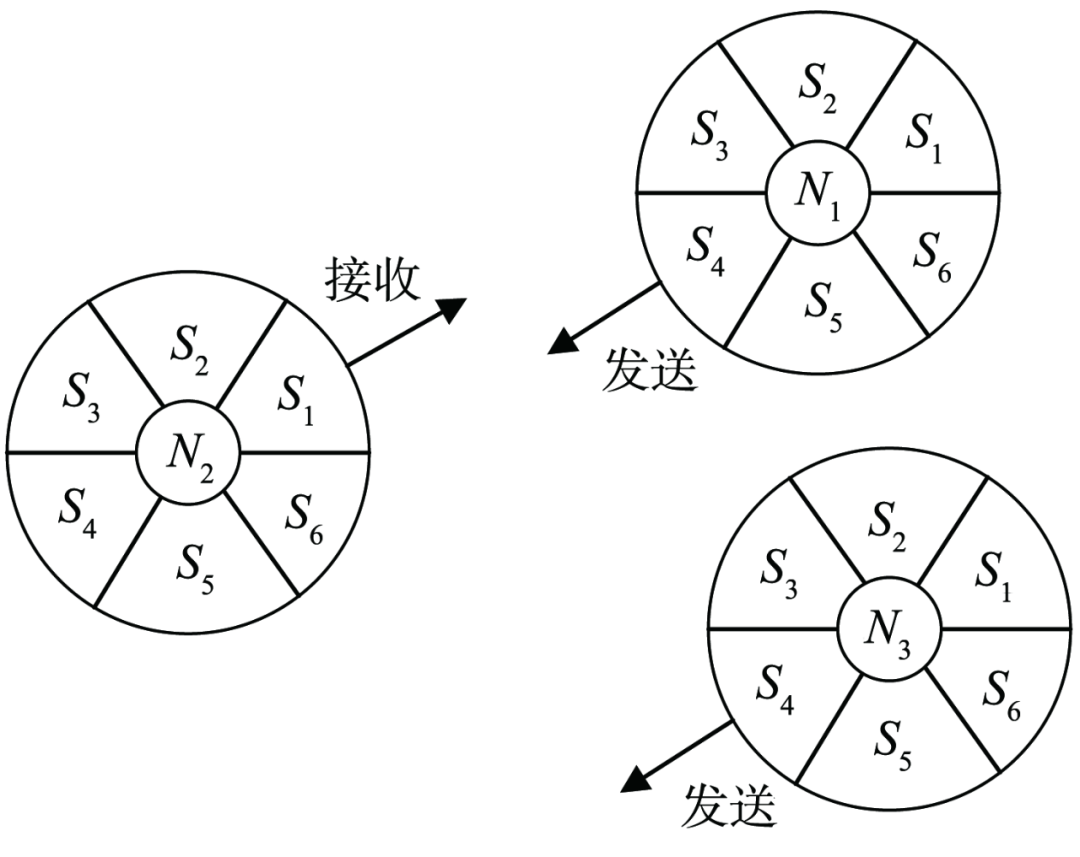
(a)t1 Node sector transmission and reception status at time
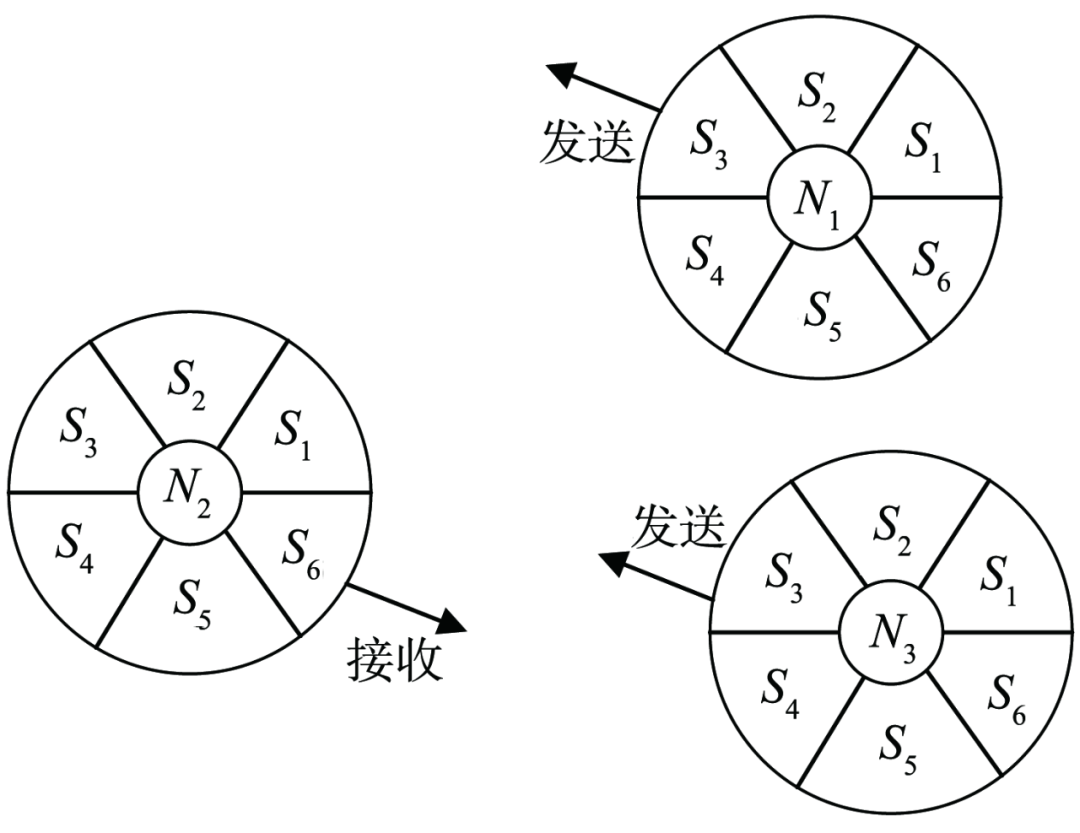
(b)t2 Node sector transmission and reception status at time
Figure 3: Terahertz Cooperative Networking Node Convergence Process
4.2 Key Technology Research of Terahertz Cooperative Networking
4.2.1 Ultra-Wideband Baseband Processing Technology
(1) Single Carrier Block Transmission Technology
The main research direction of single carrier systems is Single Carrier Time Domain Equalization (SC-TDE). The high computational complexity of time domain equalizers severely affects the development of single carrier systems. In recent years, SC-FDE has gained increasing attention, as it transforms the time domain equalization of SC-TDE into the frequency domain, and can reduce the computational load to some extent when the channel delay is large.

Figure 4: SC-FDE System Block Diagram
(2) Research on Adaptive Coding Modulation and Low Complexity Transceiver Processing Technology
Terahertz long-distance wireless communication has broad application prospects. However, some non-ideal RF characteristics inevitably arise in Terahertz communication systems, the most significant of which include phase noise and in-phase and quadrature (IQ) imbalance. Amplitude Phase Shift Keying (APSK) has gained widespread attention due to its advantages of high spectral and power efficiency, along with its tolerance to nonlinear distortion. APSK technology can be applied to Terahertz communication systems to enhance signal tolerance to non-ideal RF characteristics.
If the set S represents a certain APSK constellation point set, then S can be defined as follows:
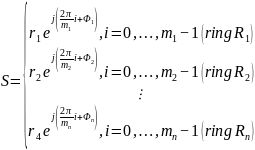 (1)
(1)
Where  represents the number of rings in the constellation,
represents the number of rings in the constellation,  represents the kth ring in the constellation,
represents the kth ring in the constellation,  represents the number of constellation points on the kth ring,
represents the number of constellation points on the kth ring,  represents the initial phase of the kth ring, and
represents the initial phase of the kth ring, and  represents the radius of the kth ring. A 256-order APSK constellation diagram is shown in Figure 5.
represents the radius of the kth ring. A 256-order APSK constellation diagram is shown in Figure 5.
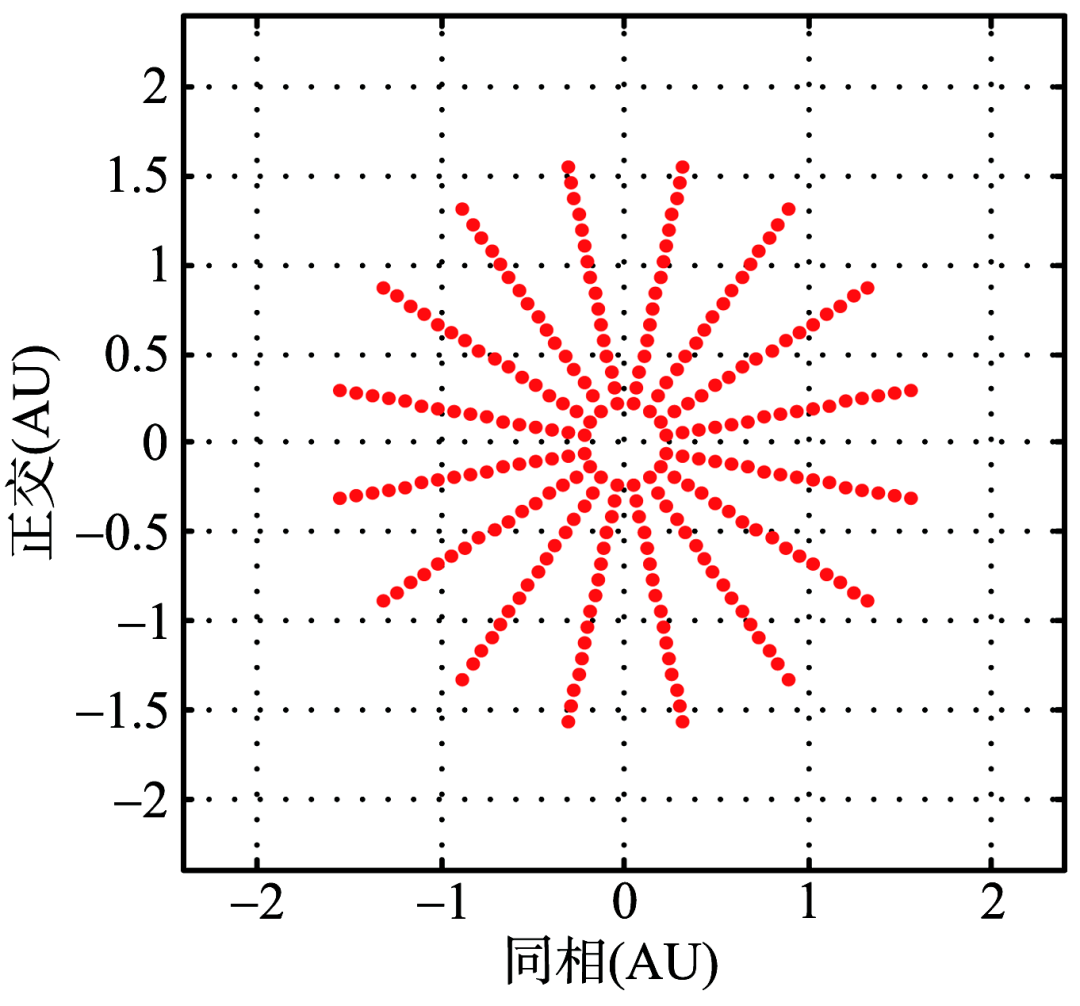
Figure 5: 16×16-APSK Constellation Diagram
The value of the constellation diagram  is 16,
is 16,  is 16, and
is 16, and  is π/16. For this type of constellation diagram where the number of constellation points on each ring is the same, it is called -APSK. If S represents the signal modulated by APSK, it is assumed that all APSK constellation diagrams meet the average power constraint condition in subsequent studies, that is:
is π/16. For this type of constellation diagram where the number of constellation points on each ring is the same, it is called -APSK. If S represents the signal modulated by APSK, it is assumed that all APSK constellation diagrams meet the average power constraint condition in subsequent studies, that is:
 (2)
(2)
If M represents the total number of points in the constellation, assuming that the probability of each constellation point being taken is equal to 1/M, then equation (2) can be expressed as:
 (3)
(3)
Where an APSK constellation diagram is determined by the number of rings  , the number of points on each ring
, the number of points on each ring  , the initial phase of each ring
, the initial phase of each ring  , and the radius of each ring
, and the radius of each ring  . Therefore, the APSK constellation diagram is highly flexible; even if the order M remains unchanged, numerous APSK constellation diagrams can be generated by altering any one or several of the four parameters mentioned above as needed.
. Therefore, the APSK constellation diagram is highly flexible; even if the order M remains unchanged, numerous APSK constellation diagrams can be generated by altering any one or several of the four parameters mentioned above as needed.

Figure 6: Terahertz Communication System Model
The narrow APSK constellation diagram requires that the number of signal points on the outer ring is not less than the constellation points on the inner rings, that is:
 (4)
(4)
The Terahertz communication system model used is shown in Figure 6.
The signal S modulated by APSK can be represented as a two-dimensional column vector:
 (5)
(5)
Where  represents the in-phase component of the signal and
represents the in-phase component of the signal and  represents the quadrature component of the signal.
represents the quadrature component of the signal.
The signal S is first affected by phase noise, rotating the original signal points by an angle θ in a clockwise direction. If matrix R represents the phase noise matrix, then
 (6)
(6)
After passing through a Gaussian white noise channel, the signal is equivalent to adding a two-dimensional Gaussian white noise vector n to the original signal and is then affected by IQ imbalance, ultimately resulting in the received signal vector r.
(3) Baseband Processing Module Design Technology Research
The block diagram of the Terahertz system baseband processing module is shown in Figure 7, which mainly includes an ADC (Analog-to-Digital Converter) module, a DAC (Digital-to-Analog Converter) module, and a Zynq processor that includes FPGA and ARM. The FPGA part is used for link calculation and switching control, while the ARM processor part is used for network protocol processing and antenna direction analysis. The data reception process involves the following: the intermediate frequency signal from the RF front end undergoes analog-to-digital conversion via the ADC module, and the digital signal output from the ADC enters the Zynq processor, ultimately outputting the source data. The data transmission process is as follows: source data undergoes processing through the Zynq processor to obtain the digital information to be transmitted, which is then converted from digital to analog via the DAC module, finally outputting the intermediate frequency analog signal to be transmitted.

Figure 7: Block Diagram of Terahertz Baseband Processing Module
4.2.2 Compensation Technology for Non-Ideal Characteristics of RF/Baseband Hardware
(1) Power Amplifier Nonlinearity Compensation
Given the ultra-high data rates and bandwidth of Terahertz signals, real-time predistortion processing in practical Terahertz systems is challenging. A predistortion processing method can be considered to reduce the system’s requirements on the ADC, with the proposed scheme shown in Figure 8.

Figure 8: Offline Compensation Scheme for Power Amplifier Nonlinearity
Using offline compensation for power amplifier nonlinearity can effectively improve the EVM (Error Vector Magnitude) metrics of the transmitted signal. Preliminary research using Pass-band droop = 4 dB as an example shows the constellation diagrams before and after frequency sweeping calibration, indicating that the EVM value of the QPSK signal decreased by 4 dB after frequency sweeping compensation.

Figure 9: Spectrogram Before and After Calibration
(2) IQ Imbalance Processing Technology
In Terahertz communication, due to high frequency and large bandwidth, the frequency-domain non-independence of IQ imbalance is quite pronounced, mainly involving gain imbalance, phase imbalance, and filter response imbalance.
IQ imbalance signal compensation: IQ imbalance compensation is the goal of the entire IQ imbalance research, representing the inverse process introduced by IQ imbalance. Compensation is usually based on parameter estimation and can generally be divided into two categories: one situation is where parameter estimation and signal compensation are separated; the other situation is adaptive compensation, where parameter estimation is continuously corrected based on the signal compensation situation, with both interacting through feedback loops. Both aspects should be explored to develop corresponding compensation algorithms and realize circuit structures, finding an optimal compromise between compensation performance and implementation complexity.
(3) Phase Noise Suppression Technology
In the Terahertz frequency band, phase noise is significantly higher compared to lower frequency bands. Moreover, when using high-order modulation like QAM, the phase noise issue in Terahertz will be even more pronounced. Additionally, considering the requirements for low-cost and low-power RF front ends, solely relying on RF technology to mitigate the adverse effects of phase noise is not feasible. Therefore, in designing Terahertz wireless communication systems, estimating and suppressing phase noise at baseband will be more feasible.
When researching phase noise suppression methods in Terahertz systems, the phase noise of the designed RF system will be tested, and further improvements will be made to the phase noise suppression methods to minimize the impact of phase noise on system performance.
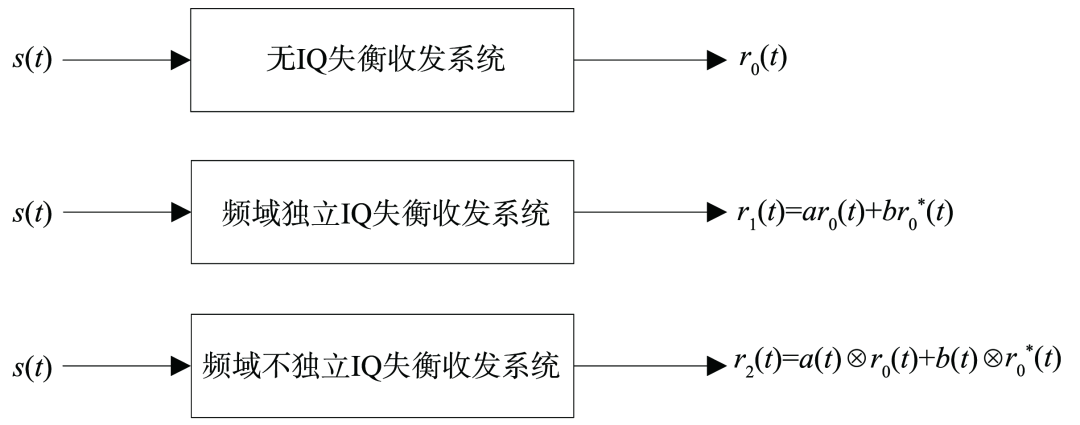
Figure 10: IQ Imbalance Signal Model Illustration
5 Conclusion
Terahertz frequency bands possess advantages such as high rates, strong directionality, high security, low scattering, and good penetration, making Terahertz technology a primary means of application in aircraft cooperative networking, significantly enhancing the cooperative networking capabilities and information sharing capabilities of aircraft platforms. However, the development of high-power Terahertz sources, high-sensitivity Terahertz detectors, and amplifiers remains a constraint on Terahertz communication. Future applications of Terahertz technology in aircraft cooperative networking should focus on the development of Terahertz components, the construction of Terahertz transmission models, and the improvement of theoretical models of Terahertz in atmospheric transmission, along with system-level validation on typical aircraft platforms.
In the future, attention should be paid to the development of Terahertz technology both domestically and internationally, continuously building knowledge reserves for Terahertz technology research; simultaneously, attention should be given to the application directions and mechanisms of Terahertz technology related to aircraft, especially in high-speed platforms, and targeted special research should be conducted to proactively occupy the high ground of Terahertz technology, which is of great significance for enhancing the applications in the field of aircraft and improving national military capabilities.
Corresponding Author: Chi Cheng, Engineer, main research direction is overall design of data links.
Citation Format: Chi Cheng. Application of Terahertz Technology in Aircraft Platform Cooperative Networking [J]. Tactical Missile Technology, 2021, (3): 28-34. (Chi Cheng. Application of Terahertz Technology in Aircraft Platform Cooperative Networking [J]. Tactical Missile Technology, 2021, (3): 28-34.)
Source | “Tactical Missile Technology” 2021 Issue 3
“Tactical Missile Technology” is supervised by China Aerospace Science and Industry Corporation, hosted by China Aerospace Science and Industry Corporation Flight Technology Research Institute, and undertaken by Beijing Haiying Technology Information Research Institute. It is an academic journal that serves missile research, design, manufacturing, testing, and usage. Founded in 1980, it is a bimonthly publication, recognized as a “Chinese Core Journal” and “Chinese Science and Technology Core Journal,” and is publicly distributed both domestically and internationally. The journal mainly publishes academic papers on overall technology, mission planning technology, propulsion technology, guidance, navigation, and control technology related to missiles and missile weapon systems.

Correspondence Address: Beijing 7254 Mailbox 4 Sub-box (100074)
Phone: (010)68375662 (Editor)
(010)68375084 (Distribution)
Email: [email protected]
Website: www.haiying.org.cn
Welcome to submit!